Recent Advances of Doped SnO2 as Electron Transport Layer for High-Performance Perovskite Solar Cells
Abstract
:1. Introduction
2. Inorganic–Organic Halide Perovskite Solar Cell
2.1. Device Configuration and Working Mechanism of Halide Perovskite Solar Cells
2.1.1. Device Configuration
2.1.2. Working Mechanism of Halide Perovskite Solar Cells
2.2. Challenge in the ETL of PSC
2.2.1. Temperature Process
2.2.2. ETL/Perovskite Interface
2.2.3. Hysteresis Behavior
2.2.4. ETL Thickness
3. Crystal Structure, Electronic Properties, and Optical Properties of SnO2 and Doped SnO2
3.1. Intrinsic Semiconductor SnO2
3.2. Doped SnO2
4. Doping Engineering of SnO2
4.1. Metal Doping
4.2. Nonmetal Doping
4.3. Composite Doping
4.4. Organic Doping
5. Outlook and Perspective
Funding
Data Availability Statement
Conflicts of Interest
References
- Chen, Y.; Meng, Q.; Zhang, L.; Han, C.; Gao, H.; Zhang, Y.; Yan, H. SnO2-based electron transporting layer materials for perovskite solar cells: A review of recent progress. J. Energy Chem. 2019, 35, 144–167. [Google Scholar] [CrossRef]
- Kim, J.Y.; Lee, J.-W.; Jung, H.S.; Shin, H.; Park, N.-G. High-Efficiency Perovskite Solar Cells. Chem. Rev. 2020, 120, 7867–7918. [Google Scholar] [CrossRef] [PubMed]
- Nabipour, H.; Wang, X.; Song, L.; Hu, Y. Organic-inorganic hybridization of isoreticular metal-organic framework-3 with melamine for efficiently reducing the fire risk of epoxy resin. Compos. Part B Eng. 2021, 211, 108606. [Google Scholar] [CrossRef]
- Han, P.; Liu, F.; Zhang, Y.; Wang, Y.; Qin, G.; Hou, L.; Yuan, C. Organic–Inorganic Hybridization Engineering of Polyperylenediimide Cathodes for Efficient Potassium Storage. Angew. Chem. Int. Ed. 2021, 60, 23596–23601. [Google Scholar] [CrossRef]
- Wu, Z.; Zhang, L.; Li, J.; Zhao, X.; Yang, C. Organic–inorganic hybridization for the synthesis of robust in situ hydrophobic polypropylsilsesquioxane aerogels with fast oil absorption properties. RSC Adv. 2018, 8, 5695–5701. [Google Scholar] [CrossRef] [PubMed]
- Kojima, A.; Teshima, K.; Shirai, Y.; Miyasaka, T. Organometal Halide Perovskites as Visible-Light Sensitizers for Photovoltaic Cells. J. Am. Chem. Soc. 2009, 131, 6050–6051. [Google Scholar] [CrossRef] [PubMed]
- Kim, H.-S.; Lee, C.-R.; Im, J.-H.; Lee, K.-B.; Moehl, T.; Marchioro, A.; Moon, S.-J.; Humphry-Baker, R.; Yum, J.-H.; Moser, J.E.; et al. Lead Iodide Perovskite Sensitized All-Solid-State Submicron Thin Film Mesoscopic Solar Cell with Efficiency Exceeding 9%. Sci. Rep. 2012, 2, 591. [Google Scholar] [CrossRef]
- Heo, J.H.; Im, S.H.; Noh, J.H.; Mandal, T.N.; Lim, C.-S.; Chang, J.A.; Lee, Y.H.; Kim, H.-J.; Sarkar, A.; Nazeeruddin, M.K.; et al. Efficient inorganic–organic hybrid heterojunction solar cells containing perovskite compound and polymeric hole conductors. Nat. Photonics 2013, 7, 486–491. [Google Scholar] [CrossRef]
- Im, J.-H.; Lee, C.-R.; Lee, J.-W.; Park, S.-W.; Park, N.-G. 6.5% efficient perovskite quantum-dot-sensitized solar cell. Nanoscale 2011, 3, 4088–4093. [Google Scholar] [CrossRef]
- Lee, J.-W.; Seol, D.-J.; Cho, A.-N.; Park, N.-G. High-Efficiency Perovskite Solar Cells Based on the Black Polymorph of HC(NH2)2PbI3. Adv. Mater. 2014, 26, 4991–4998. [Google Scholar] [CrossRef]
- Im, J.H.; Jang, I.H.; Pellet, N.; Grätzel, M.; Park, N.G. Growth of CH3NH3PbI3 cuboids with controlled size for high-efficiency perovskite solar cells. Nat. Nanotechnol. 2014, 9, 927–932. [Google Scholar] [CrossRef] [PubMed]
- Son, D.-Y.; Lee, J.-W.; Choi, Y.J.; Jang, I.-H.; Lee, S.; Yoo, P.J.; Shin, H.; Ahn, N.; Choi, M.; Kim, D.; et al. Self-formed grain boundary healing layer for highly efficient CH3NH3PbI3 perovskite solar cells. Nat. Energy 2016, 1, 16081. [Google Scholar] [CrossRef]
- Zheng, S.; Wang, G.; Liu, T.; Lou, L.; Xiao, S.; Yang, S. Materials and structures for the electron transport layer of efficient and stable perovskite solar cells. Sci. China Chem. 2019, 62, 800–809. [Google Scholar] [CrossRef]
- Jung, H.S.; Park, N.-G. Perovskite Solar Cells: From Materials to Devices. Small 2015, 11, 10–25. [Google Scholar] [CrossRef]
- Wei, J.; Zhang, C.; Ji, G.; Han, Y.; Ismail, I.; Li, H.; Luo, Q.; Yang, J.; Ma, C.-Q. Roll-to-roll printed stable and thickness-independent ZnO:PEI composite electron transport layer for inverted organic solar cells. Sol. Energy 2019, 193, 102–110. [Google Scholar] [CrossRef]
- Liu, C.; Xiao, C.; Li, W. Zinc oxide nanoparticles as electron transporting interlayer in organic solar cells. J. Mater. Chem. C 2021, 9, 14093–14114. [Google Scholar] [CrossRef]
- Wei, J.; Guoqi, J.; Zhang, C.; Yan, L.; Luo, Q.; Wang, C.; Chen, Q.; Yang, J.; Chen, L.; Ma, C.-Q. Silane Capped ZnO Nanoparticles for Use as the Electron Transport Layer in Inverted Organic Solar Cells. ACS Nano 2018, 12, 5518–5529. [Google Scholar] [CrossRef]
- Dong, J.; Wu, J.; Jia, J.; He, X.; Lan, Z.; Fan, L.; Lin, J.; Huang, M. Annealing-Free Cr2O3 Electron-Selective Layer for Efficient Hybrid Perovskite Solar Cells. ChemSusChem 2018, 11, 619–628. [Google Scholar] [CrossRef]
- Gheno, A.; Thu Pham, T.T.; Di Bin, C.; Bouclé, J.; Ratier, B.; Vedraine, S. Printable WO3 electron transporting layer for perovskite solar cells: Influence on device performance and stability. Sol. Energy Mater. Sol. Cells 2017, 161, 347–354. [Google Scholar] [CrossRef]
- Pandey, R.; Saini, A.P.; Chaujar, R. Numerical simulations: Toward the design of 18.6% efficient and stable perovskite solar cell using reduced cerium oxide based ETL. Vacuum 2019, 159, 173–181. [Google Scholar] [CrossRef]
- Feng, J.; Yang, Z.; Yang, D.; Ren, X.; Zhu, X.; Jin, Z.; Zi, W.; Wei, Q.; Liu, S. E-beam evaporated Nb2O5 as an effective electron transport layer for large flexible perovskite solar cells. Nano Energy 2017, 36, 1–8. [Google Scholar] [CrossRef]
- Yoon, S.; Kim, S.J.; Kim, H.S.; Park, J.-S.; Han, I.K.; Jung, J.W.; Park, M. Solution-processed indium oxide electron transporting layers for high-performance and photo-stable perovskite and organic solar cells. Nanoscale 2017, 9, 16305–16312. [Google Scholar] [CrossRef] [PubMed]
- Hu, J.; Wang, T.; Wang, Y.; Huang, D.; He, G.; Han, Y.; Hu, N.; Su, Y.; Zhou, Z.; Zhang, Y.; et al. Enhanced formaldehyde detection based on Ni doping of SnO2 nanoparticles by one-step synthesis. Sens. Actuators B Chem. 2018, 263, 120–128. [Google Scholar] [CrossRef]
- Sun, C.; Guan, L.; Guo, Y.; Fang, B.; Yang, J.; Duan, H.; Chen, Y.; Li, H.; Liu, H. Ternary oxide BaSnO3 nanoparticles as an efficient electron-transporting layer for planar perovskite solar cells. J. Alloys Compd. 2017, 722, 196–206. [Google Scholar] [CrossRef]
- Leung, D.Y.C.; Fu, X.; Wang, C.; Ni, M.; Leung, M.K.H.; Wang, X.; Fu, X. Hydrogen Production over Titania-Based Photocatalysts. ChemSusChem 2010, 3, 681–694. [Google Scholar] [CrossRef]
- Rauf, M.A.; Meetani, M.A.; Hisaindee, S. An overview on the photocatalytic degradation of azo dyes in the presence of TiO2 doped with selective transition metals. Desalination 2011, 276, 13–27. [Google Scholar] [CrossRef]
- Park, H.; Park, Y.; Kim, W.; Choi, W. Surface modification of TiO2 photocatalyst for environmental applications. J. Photochem. Photobiol. C Photochem. Rev. 2013, 15, 1–20. [Google Scholar] [CrossRef]
- Vasilopoulou, M.; Soultati, A.; Filippatos, P.-P.; Mohd Yusoff, A.R.b.; Nazeeruddin, M.K.; Palilis, L.C. Charge transport materials for mesoscopic perovskite solar cells. J. Mater. Chem. C 2022, 10, 11063–11104. [Google Scholar] [CrossRef]
- Krishna, A.; Grimsdale, A.C. Hole transporting materials for mesoscopic perovskite solar cells–towards a rational design? J. Mater. Chem. A 2017, 5, 16446–16466. [Google Scholar] [CrossRef]
- Yang, D.; Yang, R.; Wang, K.; Wu, C.; Zhu, X.; Feng, J.; Ren, X.; Fang, G.; Priya, S.; Liu, S. High efficiency planar-type perovskite solar cells with negligible hysteresis using EDTA-complexed SnO2. Nat. Commun. 2018, 9, 3239. [Google Scholar] [CrossRef]
- Cui, P.; Wei, D.; Ji, J.; Huang, H.; Jia, E.; Dou, S.; Wang, T.; Wang, W.; Li, M. Planar p–n homojunction perovskite solar cells with efficiency exceeding 21.3%. Nat. Energy 2019, 4, 150–159. [Google Scholar] [CrossRef]
- Liu, F.; Li, Q.; Li, Z. Hole-Transporting Materials for Perovskite Solar Cells. Asian J. Org. Chem. 2018, 7, 2182–2200. [Google Scholar] [CrossRef]
- Zhou, D.; Zhou, T.; Tian, Y.; Zhu, X.; Tu, Y. Perovskite-Based Solar Cells: Materials, Methods, and Future Perspectives. J. Nanomater. 2018, 2018, 8148072. [Google Scholar] [CrossRef]
- Das, S.; Jayaraman, V. SnO2: A comprehensive review on structures and gas sensors. Prog. Mater. Sci. 2014, 66, 112–255. [Google Scholar] [CrossRef]
- Deng, H.-X.; Li, S.-S.; Li, J. Quantum Confinement Effects and Electronic Properties of SnO2 Quantum Wires and Dots. J. Phys. Chem. C 2010, 114, 4841–4845. [Google Scholar] [CrossRef]
- Mao, G.-P.; Wang, W.; Shao, S.; Sun, X.-J.; Chen, S.-A.; Li, M.-H.; Li, H.-M. Correction to: Research progress in electron transport layer in perovskite solar cells. Rare Met. 2020. [Google Scholar] [CrossRef]
- Ke, W.; Fang, G.; Liu, Q.; Xiong, L.; Qin, P.; Tao, H.; Wang, J.; Lei, H.; Li, B.; Wan, J.; et al. Low-Temperature Solution-Processed Tin Oxide as an Alternative Electron Transporting Layer for Efficient Perovskite Solar Cells. J. Am. Chem. Soc. 2015, 137, 6730–6733. [Google Scholar] [CrossRef]
- Tiwana, P.; Docampo, P.; Johnston, M.B.; Snaith, H.J.; Herz, L.M. Electron Mobility and Injection Dynamics in Mesoporous ZnO, SnO2, and TiO2 Films Used in Dye-Sensitized Solar Cells. ACS Nano 2011, 5, 5158–5166. [Google Scholar] [CrossRef]
- Snaith, H.J.; Ducati, C. SnO2-Based Dye-Sensitized Hybrid Solar Cells Exhibiting Near Unity Absorbed Photon-to-Electron Conversion Efficiency. Nano Lett. 2010, 10, 1259–1265. [Google Scholar] [CrossRef]
- Ren, X.; Yang, D.; Yang, Z.; Feng, J.; Zhu, X.; Niu, J.; Liu, Y.; Zhao, W.; Liu, S.F. Solution-Processed Nb:SnO2 Electron Transport Layer for Efficient Planar Perovskite Solar Cells. ACS Appl. Mater. Interfaces 2017, 9, 2421–2429. [Google Scholar] [CrossRef]
- Ke, W.; Zhao, D.; Cimaroli, A.J.; Grice, C.R.; Qin, P.; Liu, Q.; Xiong, L.; Yan, Y.; Fang, G. Effects of annealing temperature of tin oxide electron selective layers on the performance of perovskite solar cells. J. Mater. Chem. A 2015, 3, 24163–24168. [Google Scholar] [CrossRef]
- Dong, Q.; Shi, Y.; Wang, K.; Li, Y.; Wang, S.; Zhang, H.; Xing, Y.; Du, Y.; Bai, X.; Ma, T. Insight into Perovskite Solar Cells Based on SnO2 Compact Electron-Selective Layer. J. Phys. Chem. C 2015, 119, 10212–10217. [Google Scholar] [CrossRef]
- Yu, M.; Guo, Y.; Yuan, S.; Zhao, J.-S.; Qin, Y.; Ai, X.-C. The influence of the electron transport layer on charge dynamics and trap-state properties in planar perovskite solar cells. RSC Adv. 2020, 10, 12347–12353. [Google Scholar] [CrossRef]
- Guo, Z.; Gao, L.; Zhang, C.; Xu, Z.; Ma, T. Low-temperature processed non-TiO2 electron selective layers for perovskite solar cells. J. Mater. Chem. A 2018, 6, 4572–4589. [Google Scholar] [CrossRef]
- Shin, S.S.; Lee, S.J.; Seok, S.I. Metal Oxide Charge Transport Layers for Efficient and Stable Perovskite Solar Cells. Adv. Funct. Mater. 2019, 29, 1900455. [Google Scholar] [CrossRef]
- Olanrewaju, Y.A.; Orisekeh, K.; Oyelade, O.V.; Koech, R.K.; Ichwani, R.; Ebunu, A.I.; Amune, D.I.; Bello, A.; Anye, V.C.; Oyewole, O.K.; et al. Effects of temperature-dependent burn-in decay on the performance of triple cation mixed halide perovskite solar cells. AIP Adv. 2022, 12, 015122. [Google Scholar] [CrossRef]
- Zhang, Z.; Xie, L.; Lin, R.; Qin, Q.; Cai, Y.; Zhou, Y.; Liu, H.; Lu, X.; Gao, X.; Shui, L.; et al. Enhanced performance of planar perovskite solar cells based on low-temperature processed TiO2 electron transport layer modified by Li2SiO3. J. Power Sources 2018, 392, 1–7. [Google Scholar] [CrossRef]
- Yu, X.; Zou, X.; Cheng, J.; Chen, D.; Yao, Y.; Chang, C.; Liu, B.; Wang, J.; Zhou, Z.; Li, G. Investigation on Low-temperature Annealing Process of Solution-processed TiO2 Electron Transport Layer for Flexible Perovskite Solar Cell. Materials 2020, 13, 1031. [Google Scholar] [CrossRef]
- Muthukrishnan, A.P.; Lee, J.; Kim, J.; Kim, C.S.; Jo, S. Low-temperature solution-processed SnO2 electron transport layer modified by oxygen plasma for planar perovskite solar cells. RSC Adv. 2022, 12, 4883–4890. [Google Scholar] [CrossRef]
- Barbé, J.; Tietze, M.L.; Neophytou, M.; Murali, B.; Alarousu, E.; Labban, A.E.; Abulikemu, M.; Yue, W.; Mohammed, O.F.; McCulloch, I.; et al. Amorphous Tin Oxide as a Low-Temperature-Processed Electron-Transport Layer for Organic and Hybrid Perovskite Solar Cells. ACS Appl. Mater. Interfaces 2017, 9, 11828–11836. [Google Scholar] [CrossRef]
- Liu, J.; He, X.; Li, X.; Li, Y. Solvent-assisted preparation of low-temperature SnO2 electron transport layers for efficient and stable perovskite solar cells made in ambient conditions. New J. Chem. 2022, 46, 9841–9850. [Google Scholar] [CrossRef]
- Cho, A.-N.; Park, N.-G. Impact of Interfacial Layers in Perovskite Solar Cells. ChemSusChem 2017, 10, 3687–3704. [Google Scholar] [CrossRef]
- Pan, H.; Shao, H.; Zhang, X.L.; Shen, Y.; Wang, M. Interface engineering for high-efficiency perovskite solar cells. J. Appl. Phys. 2021, 129, 130904. [Google Scholar] [CrossRef]
- Snaith, H.J.; Abate, A.; Ball, J.M.; Eperon, G.E.; Leijtens, T.; Noel, N.K.; Stranks, S.D.; Wang, J.T.-W.; Wojciechowski, K.; Zhang, W. Anomalous Hysteresis in Perovskite Solar Cells. J. Phys. Chem. Lett. 2014, 5, 1511–1515. [Google Scholar] [CrossRef] [PubMed]
- Wei, J.; Li, H.; Zhao, Y.; Zhou, W.; Fu, R.; Leprince-Wang, Y.; Yu, D.; Zhao, Q. Suppressed hysteresis and improved stability in perovskite solar cells with conductive organic network. Nano Energy 2016, 26, 139–147. [Google Scholar] [CrossRef]
- Tress, W.; Marinova, N.; Moehl, T.; Zakeeruddin, S.M.; Nazeeruddin, M.K.; Grätzel, M. Understanding the rate-dependent J–V hysteresis, slow time component, and aging in CH3NH3PbI3 perovskite solar cells: The role of a compensated electric field. Energy Environ. Sci. 2015, 8, 995–1004. [Google Scholar] [CrossRef]
- Unger, E.L.; Hoke, E.T.; Bailie, C.D.; Nguyen, W.H.; Bowring, A.R.; Heumüller, T.; Christoforo, M.G.; McGehee, M.D. Hysteresis and transient behavior in current–voltage measurements of hybrid-perovskite absorber solar cells. Energy Environ. Sci. 2014, 7, 3690–3698. [Google Scholar] [CrossRef]
- Ono, L.K.; Raga, S.R.; Wang, S.; Kato, Y.; Qi, Y. Temperature-dependent hysteresis effects in perovskite-based solar cells. J. Mater. Chem. A 2015, 3, 9074–9080. [Google Scholar] [CrossRef]
- Wang, C.; Xiao, C.; Yu, Y.; Zhao, D.; Awni, R.A.; Grice, C.R.; Ghimire, K.; Constantinou, I.; Liao, W.; Cimaroli, A.J.; et al. Understanding and Eliminating Hysteresis for Highly Efficient Planar Perovskite Solar Cells. Adv. Energy Mater. 2017, 7, 1700414. [Google Scholar] [CrossRef]
- Jeyakumar, R.; Bag, A.; Nekovei, R.; Radhakrishnan, R. Influence of Electron Transport Layer (TiO2) Thickness and Its Doping Density on the Performance of CH3NH3PbI3-Based Planar Perovskite Solar Cells. J. Electron. Mater. 2020, 49, 3533–3539. [Google Scholar] [CrossRef]
- Lu, H.; Ma, Y.; Gu, B.; Tian, W.; Li, L. Identifying the optimum thickness of electron transport layers for highly efficient perovskite planar solar cells. J. Mater. Chem. A 2015, 3, 16445–16452. [Google Scholar] [CrossRef]
- Hui, W.; Yang, Y.; Xu, Q.; Gu, H.; Feng, S.; Su, Z.; Zhang, M.; Wang, J.; Li, X.; Fang, J.; et al. Red-Carbon-Quantum-Dot-Doped SnO2 Composite with Enhanced Electron Mobility for Efficient and Stable Perovskite Solar Cells. Adv. Mater. 2020, 32, 1906374. [Google Scholar] [CrossRef] [PubMed]
- Du, Y.; Cai, H.; Ni, J.; Li, J.; Yu, H.; Sun, X.; Wu, Y.; Wen, H.; Zhang, J. Air-processed, efficient CH3NH3PbI3−xClx perovskite solar cells with organic polymer PTB7 as a hole-transport layer. RSC Adv. 2015, 5, 66981–66987. [Google Scholar] [CrossRef]
- Qin, J.; Zhang, Z.; Shi, W.; Liu, Y.; Gao, H.; Mao, Y. The optimum titanium precursor of fabricating TiO2 compact layer for perovskite solar cells. Nanoscale Res. Lett. 2017, 12, 640. [Google Scholar] [CrossRef]
- Choi, J.; Song, S.; Hoerantner, M.; Snaith, H.; Park, T. A Well-Defined Nanostructured, Single Crystalline TiO2 Electron Transport Layer for Efficient Planar Perovskite Solar Cells. ACS Nano 2016, 10, 6029–6036. [Google Scholar] [CrossRef]
- Dong, Q.; Shi, Y.; Zhang, C.; Wu, Y.; Wang, L. Energetically favored formation of SnO2 nanocrystals as electron transfer layer in perovskite solar cells with high efficiency exceeding 19%. Nano Energy 2017, 40, 336–344. [Google Scholar] [CrossRef]
- Jiang, Q.; Zhang, L.; Wang, H.; Yang, X.; Meng, J.; Liu, H.; Yin, Z.; Wu, J.; Zhang, X.; You, J. Enhanced electron extraction using SnO2 for high-efficiency planar-structure HC(NH2)2PbI3-based perovskite solar cells. Nat. Energy 2016, 2, 16177. [Google Scholar] [CrossRef]
- Hoang, V.Q.; Lee, S.K.; Bark, C.W. Dispersed SnO2 colloids using sodium dodecyl benzene sulfonate for high-performance planar perovskite solar cells. Sol. Energy 2021, 230, 747–753. [Google Scholar] [CrossRef]
- Xiong, L.; Guo, Y.; Wen, J.; Liu, H.; Yang, G.; Qin, P.; Fang, G. Review on the Application of SnO2 in Perovskite Solar Cells. Adv. Funct. Mater. 2018, 28, 1802757. [Google Scholar] [CrossRef]
- Halvani Anaraki, E.; Kermanpur, A.; Mayer, M.T.; Steier, L.; Ahmed, T.; Turren-Cruz, S.-H.; Seo, J.; Luo, J.; Zakeeruddin, S.M.; Tress, W.R.; et al. Low-Temperature Nb-Doped SnO2 Electron-Selective Contact Yields over 20% Efficiency in Planar Perovskite Solar Cells. ACS Energy Lett. 2018, 3, 773–778. [Google Scholar] [CrossRef]
- Bai, Y.; Fang, Y.; Deng, Y.; Wang, Q.; Zhao, J.; Zheng, X.; Zhang, Y.; Huang, J. Low Temperature Solution-Processed Sb:SnO2 Nanocrystals for Efficient Planar Perovskite Solar Cells. ChemSusChem 2016, 9, 2686–2691. [Google Scholar] [CrossRef] [PubMed]
- Liu, J.; Li, S.; Liu, S.; Chu, Y.; Ye, T.; Qiu, C.; Qiu, Z.; Wang, X.; Wang, Y.; Su, Y.; et al. Oxygen Vacancy Management for High-Temperature Mesoporous SnO2 Electron Transport Layers in Printable Perovskite Solar Cells. Angew. Chem. Int. Ed. 2022, 61, e202202012. [Google Scholar] [CrossRef]
- Yang, G.; Qin, P.; Fang, G.; Li, G. Tin oxide (SnO2) as effective electron selective layer material in hybrid organic–inorganic metal halide perovskite solar cells. J. Energy Chem. 2018, 27, 962–970. [Google Scholar] [CrossRef]
- Wali, Q.; Iqbal, Y.; Pal, B.; Lowe, A.; Jose, R. Tin oxide as an emerging electron transport medium in perovskite solar cells. Sol. Energy Mater. Sol. Cells 2018, 179, 102–117. [Google Scholar] [CrossRef]
- Uddin, A.; Yi, H. Progress and Challenges of SnO2 Electron Transport Layer for Perovskite Solar Cells: A Critical Review. Sol. RRL 2022, 6, 2100983. [Google Scholar] [CrossRef]
- Liu, Q.; Zhang, X.; Li, C.; Lu, H.; Weng, Z.; Pan, Y.; Chen, W.; Hang, X.-C.; Sun, Z.; Zhan, Y. Effect of tantalum doping on SnO2 electron transport layer via low temperature process for perovskite solar cells. Appl. Phys. Lett. 2019, 115, 143903. [Google Scholar] [CrossRef]
- Roose, B.; Johansen, C.M.; Dupraz, K.; Jaouen, T.; Aebi, P.; Steiner, U.; Abate, A. A Ga-doped SnO2 mesoporous contact for UV stable highly efficient perovskite solar cells. J. Mater. Chem. A 2018, 6, 1850–1857. [Google Scholar] [CrossRef]
- Guo, R.; Zhao, Y.; Zhang, Y.; Deng, Q.; Shen, Y.; Zhang, W.; Shao, G. Significant performance enhancement of all-inorganic CsPbBr3 perovskite solar cells enabled by Nb-doped SnO2 as effective electron transport layer. Energy Environ. Mater. 2021, 4, 671–680. [Google Scholar] [CrossRef]
- Wang, S.; Shen, W.; Liu, J.; Ouyang, T.; Wu, Y.; Li, W.; Chen, M.; Qi, P.; Lu, Y.; Tang, Y. Improved photovoltage of printable perovskite solar cells via Nb5+ doped SnO2 compact layer. Nanotechnology 2021, 32, 145403. [Google Scholar] [CrossRef]
- Song, J.; Xu, X.; Wu, J.; Lan, Z. Low-temperature solution-processing high quality Nb-doped SnO2 nanocrystals-based electron transport layers for efficient planar perovskite solar cells. Funct. Mater. Lett. 2018, 12, 1850091. [Google Scholar] [CrossRef]
- Zhou, X.; Zhang, W.; Wang, X.; Lin, P.; Zhou, S.; Hu, T.; Tian, L.; Wen, F.; Duan, G.; Yu, L.; et al. Solution-processed Cu-doped SnO2 as an effective electron transporting layer for High-Performance planar perovskite solar cells. Appl. Surf. Sci. 2022, 584, 152651. [Google Scholar] [CrossRef]
- Ye, H.; Liu, Z.; Liu, X.; Sun, B.; Tan, X.; Tu, Y.; Shi, T.; Tang, Z.; Liao, G. 17.78% efficient low-temperature carbon-based planar perovskite solar cells using Zn-doped SnO2 electron transport layer. Appl. Surf. Sci. 2019, 478, 417–425. [Google Scholar] [CrossRef]
- Noh, Y.W.; Lee, J.H.; Jin, I.S.; Park, S.H.; Jung, J.W. Tailored electronic properties of Zr-doped SnO2 nanoparticles for efficient planar perovskite solar cells with marginal hysteresis. Nano Energy 2019, 65, 104014. [Google Scholar] [CrossRef]
- Yan, C.; Zhao, H.; Perepichka, D.F.; Rosei, F. Lanthanide Ion Doped Upconverting Nanoparticles: Synthesis, Structure and Properties. Small 2016, 12, 3888–3907. [Google Scholar] [CrossRef] [PubMed]
- Xu, Z.; Teo, S.H.; Gao, L.; Guo, Z.; Kamata, Y.; Hayase, S.; Ma, T. La-doped SnO2 as ETL for efficient planar-structure hybrid perovskite solar cells. Org. Electron. 2019, 73, 62–68. [Google Scholar] [CrossRef]
- Chen, H.; Liu, D.; Wang, Y.; Wang, C.; Zhang, T.; Zhang, P.; Sarvari, H.; Chen, Z.; Li, S. Enhanced Performance of Planar Perovskite Solar Cells Using Low-Temperature Solution-Processed Al-Doped SnO2 as Electron Transport Layers. Nanoscale Res. Lett. 2017, 12, 238. [Google Scholar] [CrossRef]
- Park, M.; Kim, J.-Y.; Son, H.J.; Lee, C.-H.; Jang, S.S.; Ko, M.J. Low-temperature solution-processed Li-doped SnO2 as an effective electron transporting layer for high-performance flexible and wearable perovskite solar cells. Nano Energy 2016, 26, 208–215. [Google Scholar] [CrossRef]
- Yang, G.; Lei, H.; Tao, H.; Zheng, X.; Ma, J.; Liu, Q.; Ke, W.; Chen, Z.; Xiong, L.; Qin, P.; et al. Reducing Hysteresis and Enhancing Performance of Perovskite Solar Cells Using Low-Temperature Processed Y-Doped SnO2 Nanosheets as Electron Selective Layers. Small 2017, 13, 1601769. [Google Scholar] [CrossRef]
- Wang, R.; Wu, J.; Wei, S.; Zhu, J.; Guo, M.; Zheng, Q.; Wei, M.; Cheng, S. Gadolinium-Doped SnO2 Electron Transfer Layer for Highly Efficient Planar Perovskite Solar Cells. J. Power Sources 2022, 544, 231870. [Google Scholar] [CrossRef]
- Wu, J.-B.; Zhen, C.; Liu, G. Photo-assisted Cl doping of SnO2 electron transport layer for hysteresis-less perovskite solar cells with enhanced efficiency. Rare Met. 2022, 41, 361–367. [Google Scholar] [CrossRef]
- Gong, W.; Guo, H.; Zhang, H.; Yang, J.; Chen, H.; Wang, L.; Hao, F.; Niu, X. Chlorine-doped SnO2 hydrophobic surfaces for large grain perovskite solar cells. J. Mater. Chem. C 2020, 8, 11638–11646. [Google Scholar] [CrossRef]
- Mo, Y.; Wang, C.; Zheng, X.; Zhou, P.; Li, J.; Yu, X.; Yang, K.; Deng, X.; Park, H.; Huang, F.; et al. Nitrogen-doped tin oxide electron transport layer for stable perovskite solar cells with efficiency over 23%. Interdiscip. Mater. 2022, 1, 309–315. [Google Scholar] [CrossRef]
- Luo, T.; Ye, G.; Chen, X.; Wu, H.; Zhang, W.; Chang, H. F-doping-Enhanced Carrier Transport in the SnO2/Perovskite Interface for High-Performance Perovskite Solar Cells. ACS Appl. Mater. Interfaces 2022, 14, 42093–42101. [Google Scholar] [CrossRef] [PubMed]
- Jiang, E.; Ai, Y.; Yan, J.; Li, N.; Lin, L.; Wang, Z.; Shou, C.; Yan, B.; Zeng, Y.; Sheng, J.; et al. Phosphate-Passivated SnO2 Electron Transport Layer for High-Performance Perovskite Solar Cells. ACS Appl. Mater. Interfaces 2019, 11, 36727–36734. [Google Scholar] [CrossRef] [PubMed]
- Wang, S.; Sakurai, T.; Wen, W.; Qi, Y. Energy Level Alignment at Interfaces in Metal Halide Perovskite Solar Cells. Adv. Mater. Interfaces 2020, 7, 2000423. [Google Scholar] [CrossRef]
- Abdi-Jalebi, M.; Andaji-Garmaroudi, Z.; Cacovich, S.; Stavrakas, C.; Philippe, B.; Richter, J.M.; Alsari, M.; Booker, E.P.; Hutter, E.M.; Pearson, A.J.; et al. Maximizing and stabilizing luminescence from halide perovskites with potassium passivation. Nature 2018, 555, 497–501. [Google Scholar] [CrossRef]
- Niu, T.; Lu, J.; Munir, R.; Li, J.; Barrit, D.; Zhang, X.; Hu, H.; Yang, Z.; Amassian, A.; Zhao, K.; et al. Stable High-Performance Perovskite Solar Cells via Grain Boundary Passivation. Adv. Mater. 2018, 30, e1706576. [Google Scholar] [CrossRef]
- Tang, Z.; Bessho, T.; Awai, F.; Kinoshita, T.; Maitani, M.M.; Jono, R.; Murakami, T.N.; Wang, H.; Kubo, T.; Uchida, S.; et al. Hysteresis-free perovskite solar cells made of potassium-doped organometal halide perovskite. Sci. Rep. 2017, 7, 12183. [Google Scholar] [CrossRef]
- Bag, S.; Durstock, M.F. Large Perovskite Grain Growth in Low-Temperature Solution-Processed Planar p-i-n Solar Cells by Sodium Addition. ACS Appl. Mater. Interfaces 2016, 8, 5053–5057. [Google Scholar] [CrossRef]
- Lin, C.C.; Murakami, T.N.; Chikamatsu, M.; Bessho, T.; Furue, M.; Segawa, H. A Sodium Chloride Modification of SnO2 Electron Transport Layers to Enhance the Performance of Perovskite Solar Cells. ACS Omega 2021, 6, 17880–17889. [Google Scholar] [CrossRef]
- Kim, S.; Zhang, F.; Tong, J.; Chen, X.; Enkhbayar, E.; Zhu, K.; Kim, J. Effects of potassium treatment on SnO2 electron transport layers for improvements of perovskite solar cells. Sol. Energy 2022, 233, 353–362. [Google Scholar]
- Zhang, S.; Gu, H.; Chen, S.-C.; Zheng, Q. KF-Doped SnO2 as an electron transport layer for efficient inorganic CsPbI2Br perovskite solar cells with enhanced open-circuit voltages. J. Mater. Chem. C 2021, 9, 4240–4247. [Google Scholar] [CrossRef]
- Zhang, L.; Li, H.; Zhuang, J.; Luan, Y.; Wu, S.; Niu, G.; Chu, L.; Cao, X.; Li, X.a.; Wang, J. Antimony trifluoride-incorporated SnO2 for high-efficiency planar perovskite solar cells. J. Mater. Chem. C 2021, 9, 15428–15434. [Google Scholar] [CrossRef]
- Tian, J.; Zhang, J.; Li, X.; Cheng, B.; Yu, J.; Ho, W. Low-Temperature-Processed Zr/F Co-Doped SnO2 Electron Transport Layer for High-Efficiency Planar Perovskite Solar Cells. Sol. RRL 2020, 4, 2000090. [Google Scholar]
- Bi, Z.; Zhang, S.; Thandapani, M.; Zhu, Y.; Zheng, Y.; Liem, N.Q.; Xiao, X.; Xu, G.; Guerrero, A.; Xu, X. High Shunt Resistance SnO2-PbO Electron Transport Layer for Perovskite Solar Cells Used in Low Lighting Applications. Adv. Sustain. Syst. 2021, 5, 2100120. [Google Scholar]
- Dagar, J.; Castro-Hermosa, S.; Lucarelli, G.; Zampetti, A.; Cacialli, F.; Brown, T.M. Low-Temperature Solution-Processed Thin SnO2/Al2O3 Double Electron Transport Layers Toward 20% Efficient Perovskite Solar Cells. IEEE J. Photovolt. 2019, 9, 1309–1315. [Google Scholar] [CrossRef]
- Albuquerque, D.; Ramos, R.; Ireno, C.; Martins, E.; Durrant, S.; Bortoleto, J. SnO2/ZnO Heterostructure as an Electron Transport Layer for Perovskite Solar Cells. Mater. Res. 2021, 24. [Google Scholar] [CrossRef]
- Wei, J.; Guo, F.; Wang, X.; Xu, K.; Lei, M.; Liang, Y.; Zhao, Y.; Xu, D. SnO2-in-Polymer Matrix for High-Efficiency Perovskite Solar Cells with Improved Reproducibility and Stability. Adv. Mater. 2018, 30, 1805153. [Google Scholar]
- Kong, T.; Wang, R.; Zheng, D.; Yu, J. Modification of the SnO2 Electron Transporting Layer by Using Perylene Diimide Derivative for Efficient Organic Solar Cells. Front. Chem. 2021, 9, 703561. [Google Scholar] [CrossRef]
- Huang, X.; Du, J.; Guo, X.; Lin, Z.; Ma, J.; Su, J.; Feng, L.; Zhang, C.; Zhang, J.; Chang, J.; et al. Polyelectrolyte-Doped SnO2 as a Tunable Electron Transport Layer for High-Efficiency and Stable Perovskite Solar Cells. Sol. RRL 2020, 4, 1900336. [Google Scholar]
- Wang, D.; Chen, S.-C.; Zheng, Q. Poly(vinylpyrrolidone)-doped SnO2 as an electron transport layer for perovskite solar cells with improved performance. J. Mater. Chem. C 2019, 7, 12204–12210. [Google Scholar] [CrossRef]
- Wang, Y.; Wan, J.; Ding, J.; Hu, J.-S.; Wang, D. A Rutile TiO2 Electron Transport Layer for the Enhancement of Charge Collection for Efficient Perovskite Solar Cells. Angew. Chem. Int. Ed. 2019, 58, 9414–9418. [Google Scholar] [CrossRef] [PubMed]
- Wang, J.; Pan, H.; Xu, X.; Jin, H.; Ma, W.; Xiong, S.; Bao, Q.; Tang, Z.; Ma, Z. Li-Doped ZnO Electron Transport Layer for Improved Performance and Photostability of Organic Solar Cells. ACS Appl. Mater. Interfaces 2022, 14, 12450–12460. [Google Scholar] [CrossRef]
- Chen, C.; Jiang, Y.; Wu, Y.; Guo, J.; Kong, X.; Wu, X.; Li, Y.; Zheng, D.; Wu, S.; Gao, X.; et al. Low-Temperature-Processed WOx as Electron Transfer Layer for Planar Perovskite Solar Cells Exceeding 20% Efficiency. Sol. RRL 2020, 4, 1900499. [Google Scholar]
- Jiang, J.; Lang, X.; Zeng, Q.; Faheem, M.B.; Rong, S.; Zhao, H.; Li, Y. Polyacetylene derivatives in perovskite solar cells: From defect passivation to moisture endurance. J. Mater. Chem. A 2021, 9, 13220–13230. [Google Scholar] [CrossRef]
- Neophytou, M.; De Bastiani, M.; Gasparini, N.; Aydin, E.; Ugur, E.; Seitkhan, A.; Moruzzi, F.; Choaie, Y.; Ramadan, A.J.; Troughton, J.R.; et al. Enhancing the Charge Extraction and Stability of Perovskite Solar Cells Using Strontium Titanate (SrTiO3) Electron Transport Layer. ACS Appl. Energy Mater. 2019, 2, 8090–8097. [Google Scholar] [CrossRef]
- Yang, J.; Xu, J.; Zhang, Q.; Xue, Z.; Liu, H.; Qin, R.; Zhai, H.; Yuan, M. An efficient and stable inverted perovskite solar cell involving inorganic charge transport layers without a high temperature procedure. RSC Adv. 2020, 10, 18608–18613. [Google Scholar] [CrossRef]
- Zhang, X.; Li, J.; Bi, Z.; He, K.; Xu, X.; Xiao, X.; Zhu, Y.; Zhan, Y.; Zhong, L.; Xu, G.; et al. Stable and efficient air-processed perovskite solar cells employing low-temperature processed compact In2O3 thin films as electron transport materials. J. Alloys Compd. 2020, 836, 155460. [Google Scholar]
- Hu, W.; Liu, T.; Yin, X.; Liu, H.; Zhao, X.; Luo, S.; Guo, Y.; Yao, Z.; Wang, J.; Wang, N.; et al. Hematite electron-transporting layers for environmentally stable planar perovskite solar cells with enhanced energy conversion and lower hysteresis. J. Mater. Chem. A 2017, 5, 1434–1441. [Google Scholar] [CrossRef]
- Zhang, J.; Hultqvist, A.; Zhang, T.; Jiang, L.; Ruan, C.; Yang, L.; Cheng, Y.; Edoff, M.; Johansson, E.M.J. Al2O3 Underlayer Prepared by Atomic Layer Deposition for Efficient Perovskite Solar Cells. ChemSusChem 2017, 10, 3810–3817. [Google Scholar] [CrossRef]
- Yi, S.; Han, D.; Yuan, Q.; Yang, Q.; Yang, Y.; Zhou, D.-Y.; Feng, L. Redox-active Eu2O3 nanoflakes as a buffer layer for inverted CsPbI2Br perovskite solar cells with enhanced performance. J. Mater. Chem. C 2020, 8, 13754–13761. [Google Scholar] [CrossRef]
- Chiang, Y.-H.; Shih, C.-K.; Sie, A.-S.; Li, M.-H.; Peng, C.-C.; Shen, P.-S.; Wang, Y.-P.; Guo, T.-F.; Chen, P. Highly stable perovskite solar cells with all-inorganic selective contacts from microwave-synthesized oxide nanoparticles. J. Mater. Chem. A 2017, 5, 25485–25493. [Google Scholar] [CrossRef]
- He, J.; Bi, E.; Tang, W.; Wang, Y.; Zhou, Z.; Yang, X.; Chen, H.; Han, L. Ligand-Free, Highly Dispersed NiOx Nanocrystal for Efficient, Stable, Low-Temperature Processable Perovskite Solar Cells. Sol. RRL 2018, 2, 1800004. [Google Scholar] [CrossRef]
- Liu, X.; Chueh, C.-C.; Zhu, Z.; Jo, S.B.; Sun, Y.; Jen, A.K.Y. Highly crystalline Zn2SnO4 nanoparticles as efficient electron-transporting layers toward stable inverted and flexible conventional perovskite solar cells. J. Mater. Chem. A 2016, 4, 15294–15301. [Google Scholar] [CrossRef]
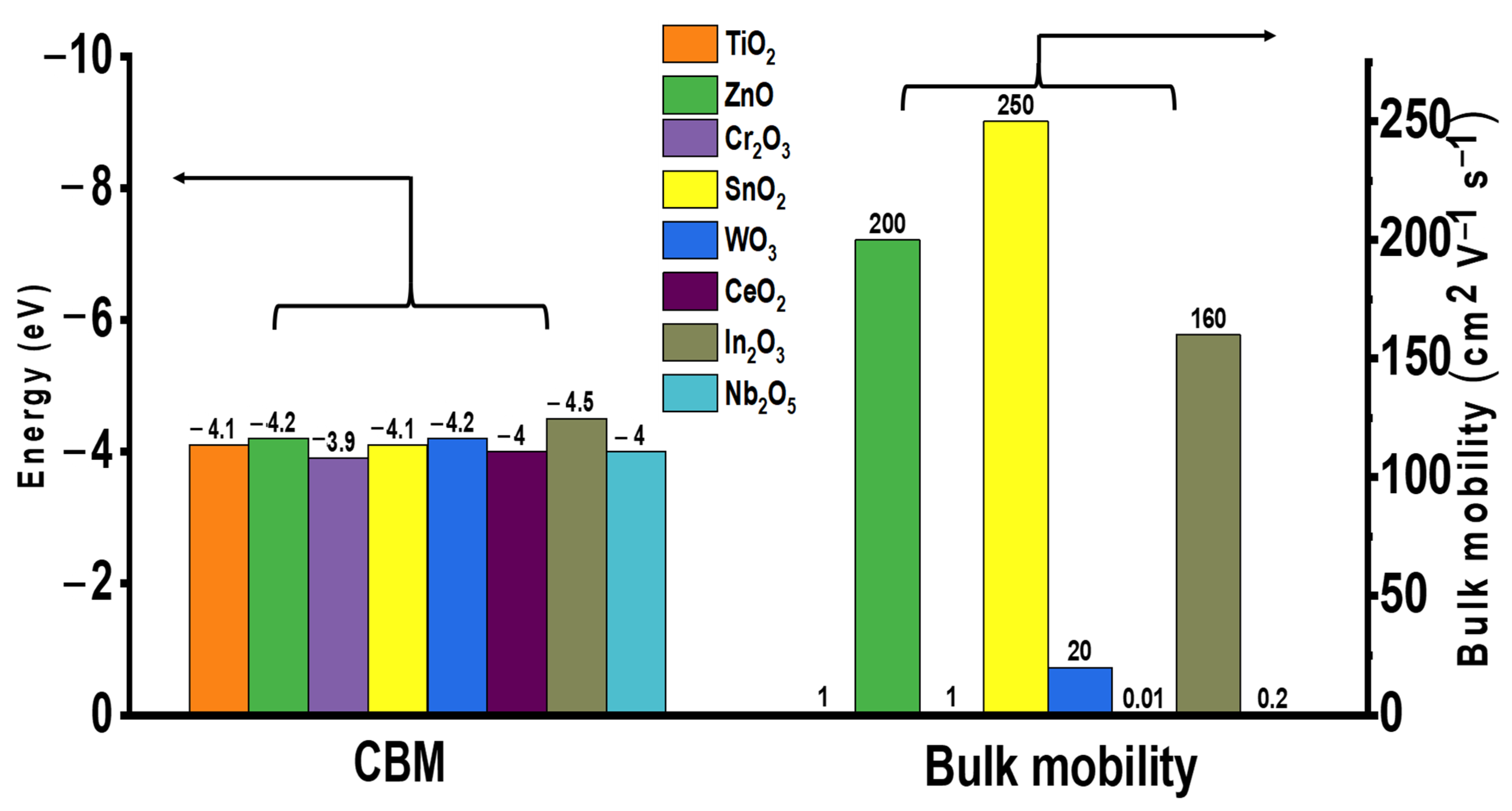
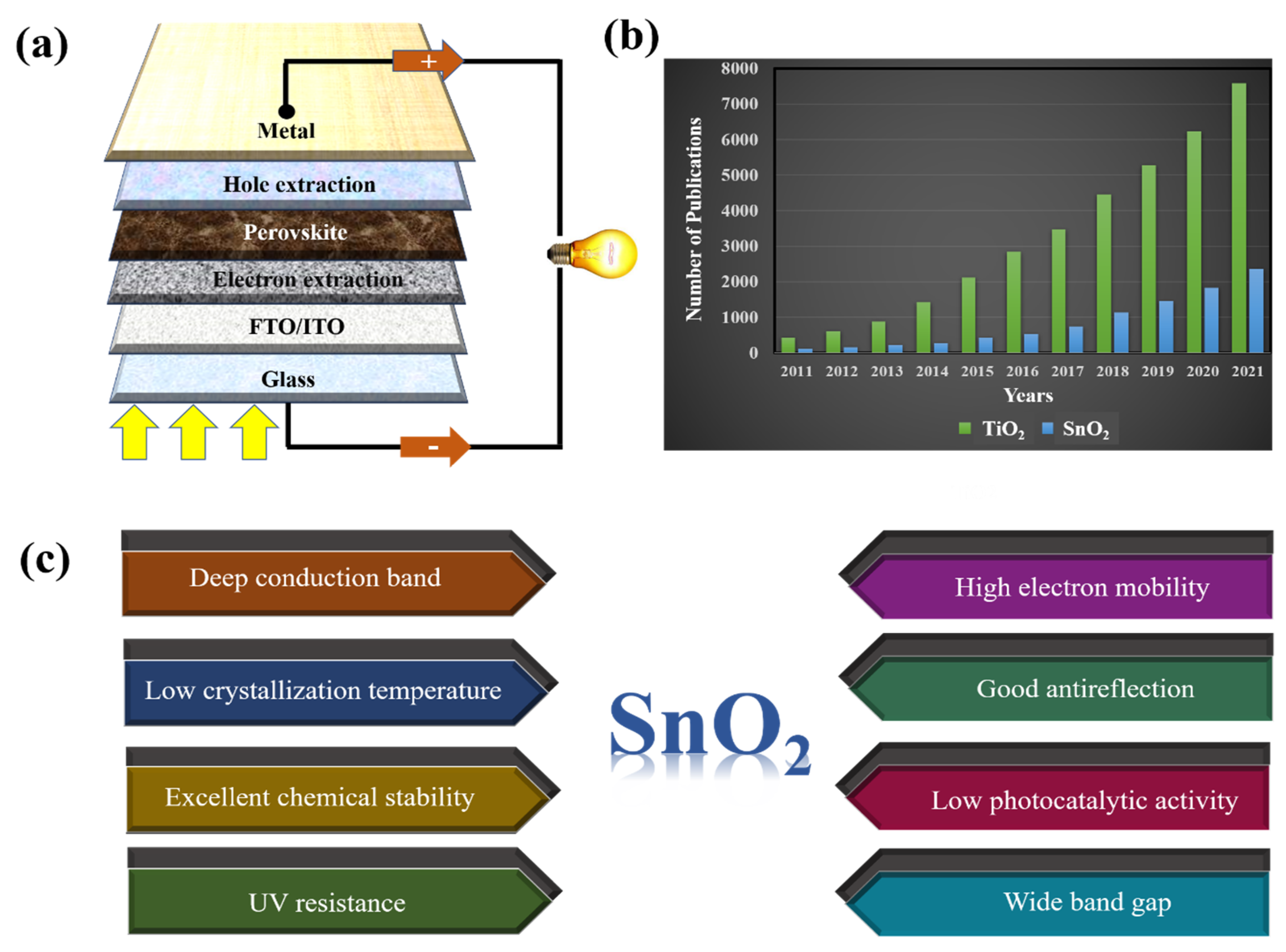
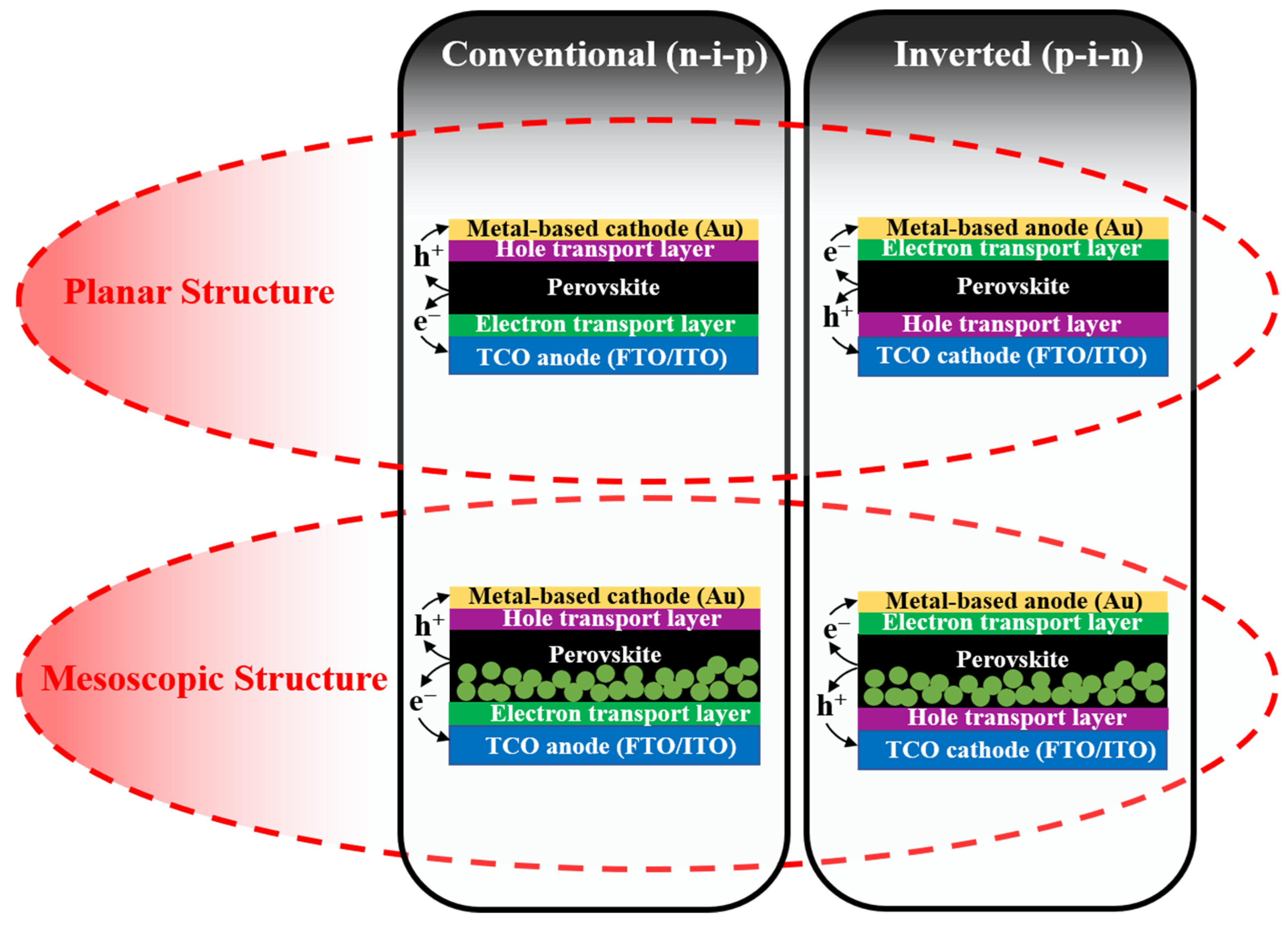


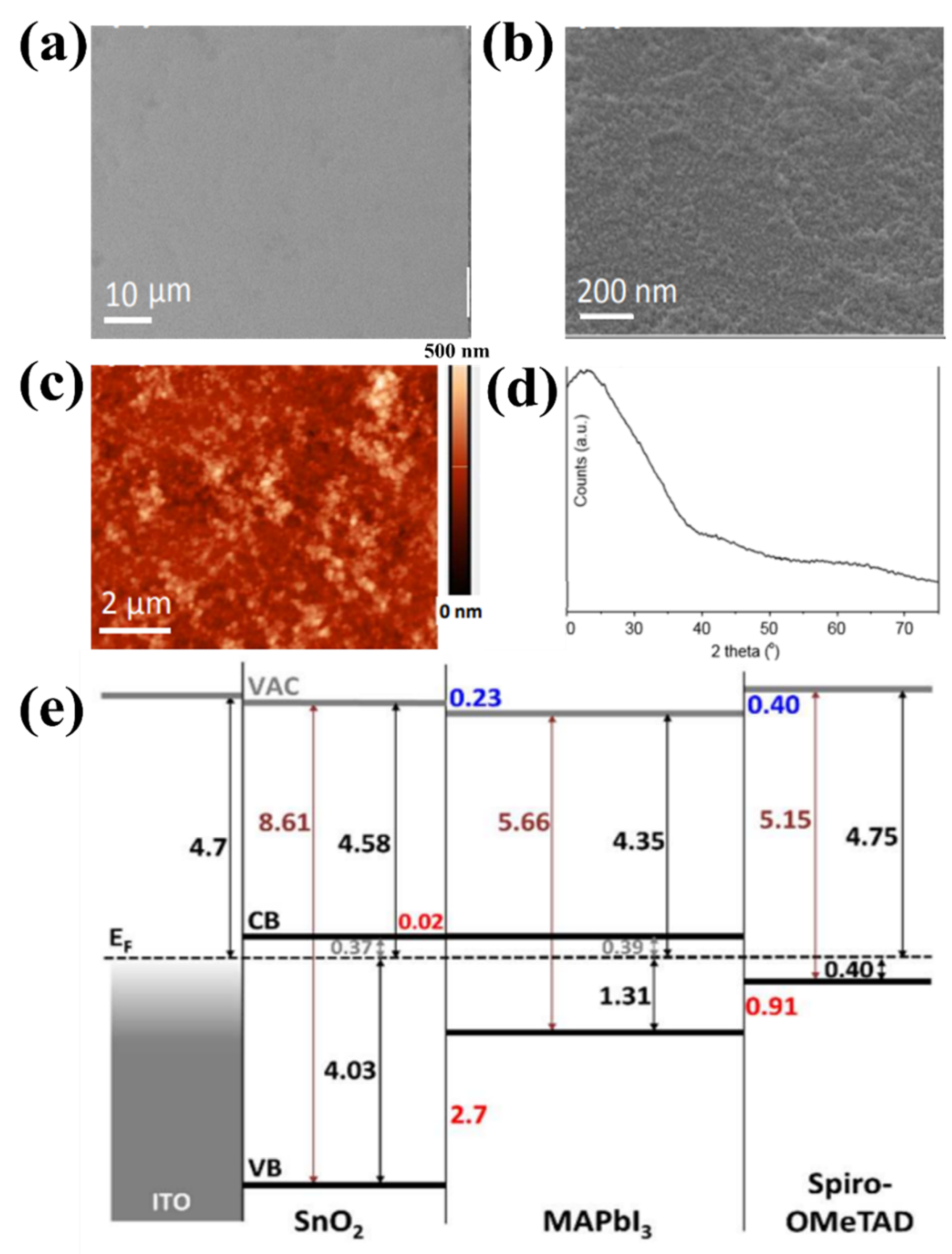
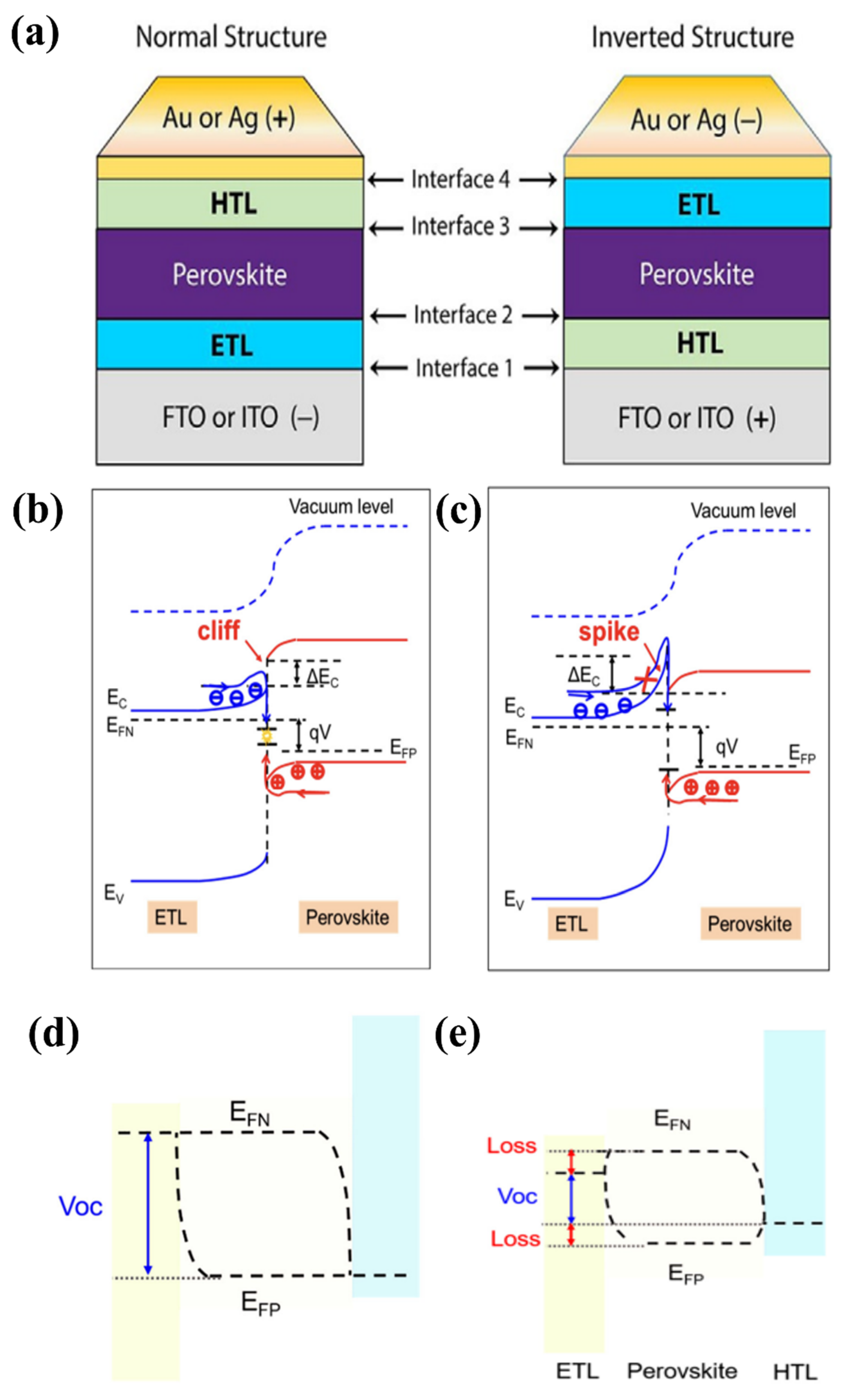
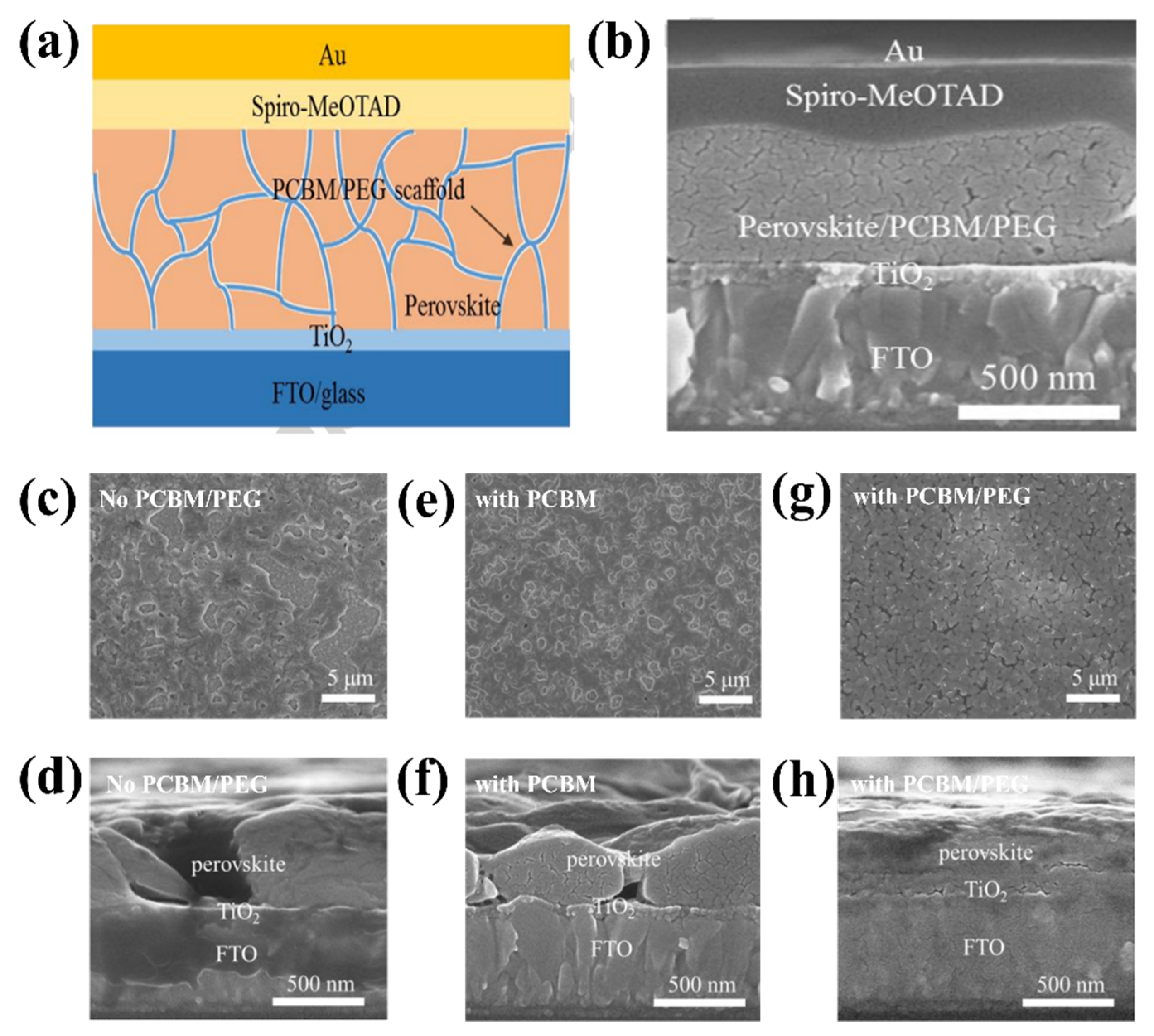
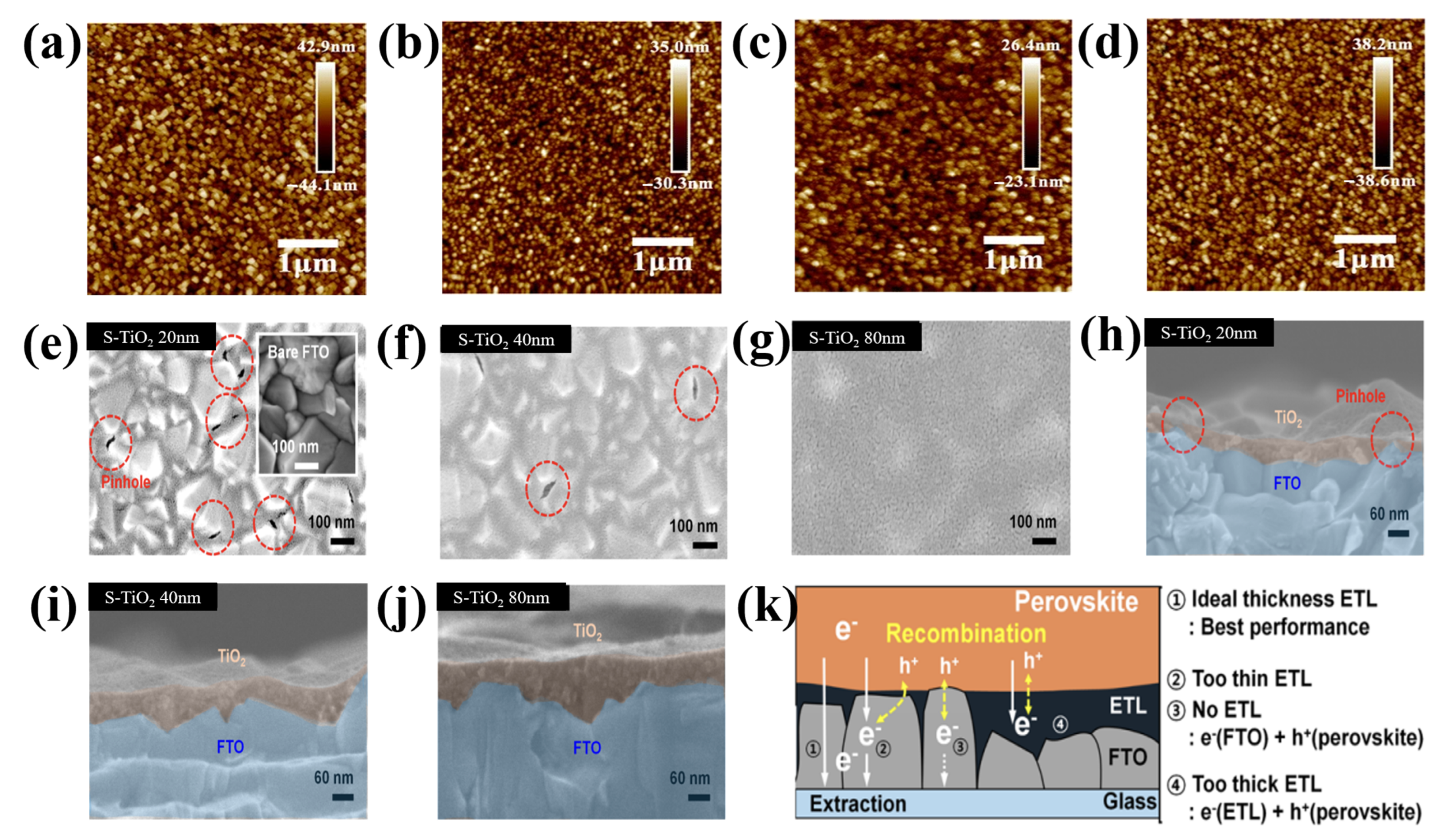
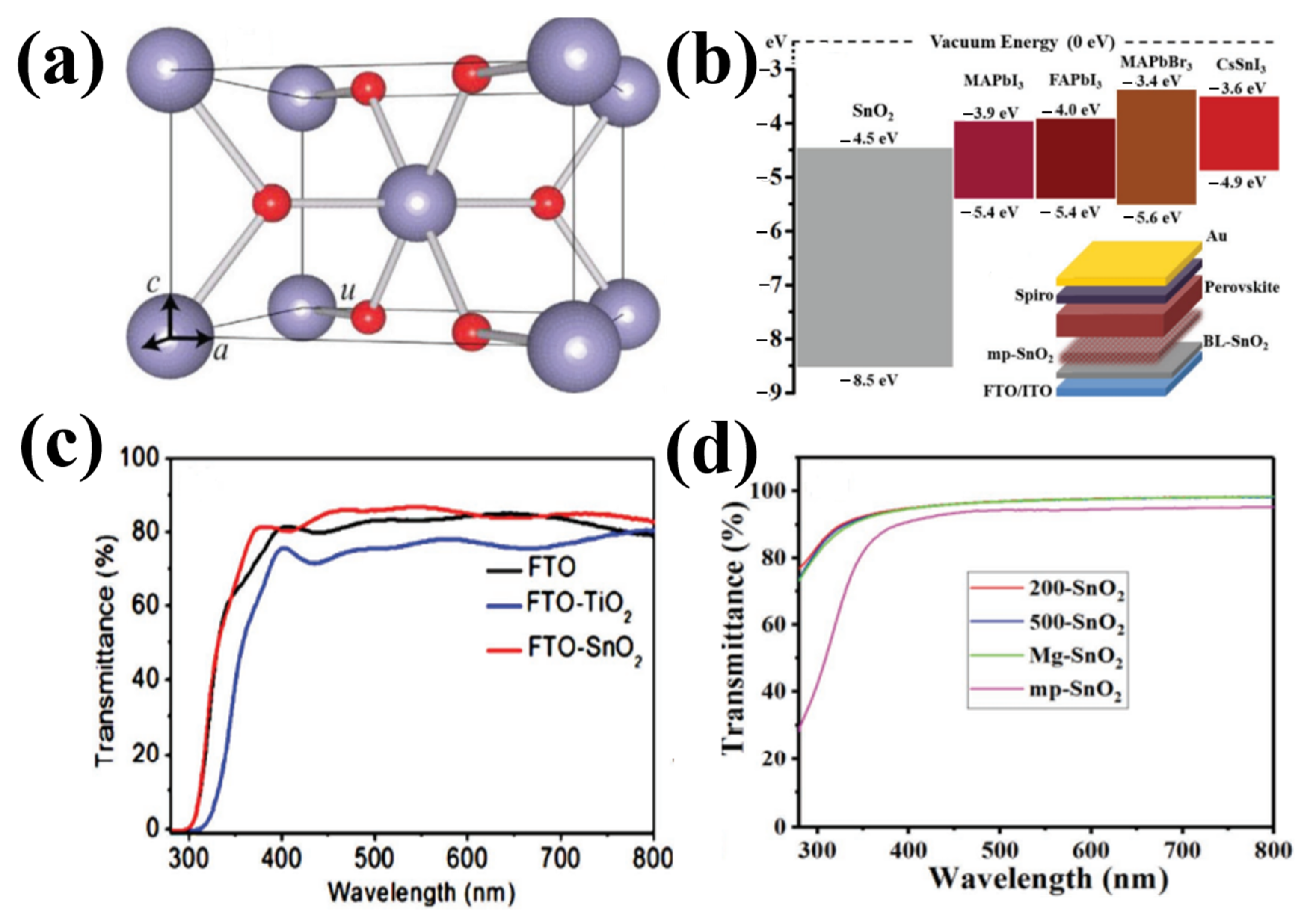
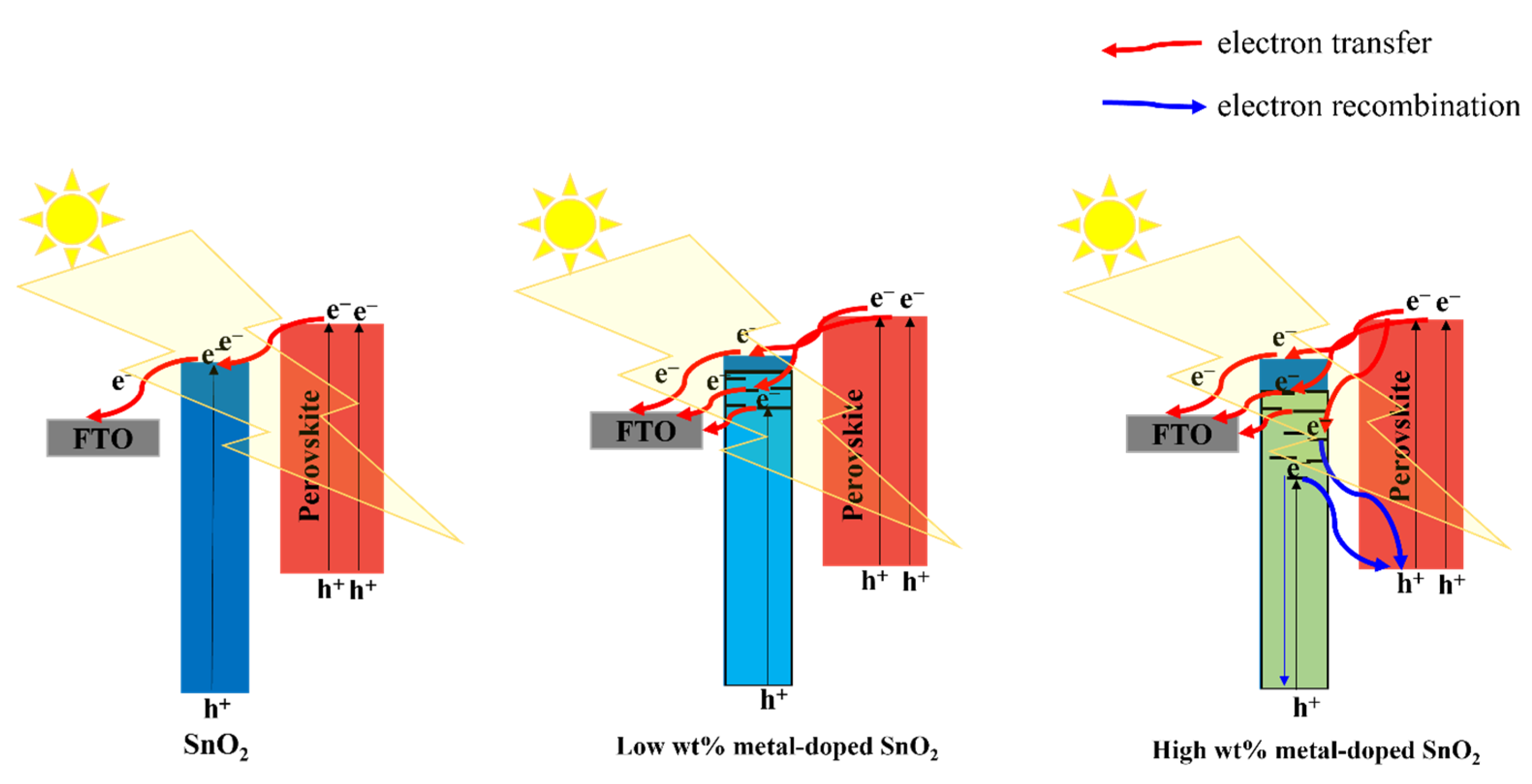
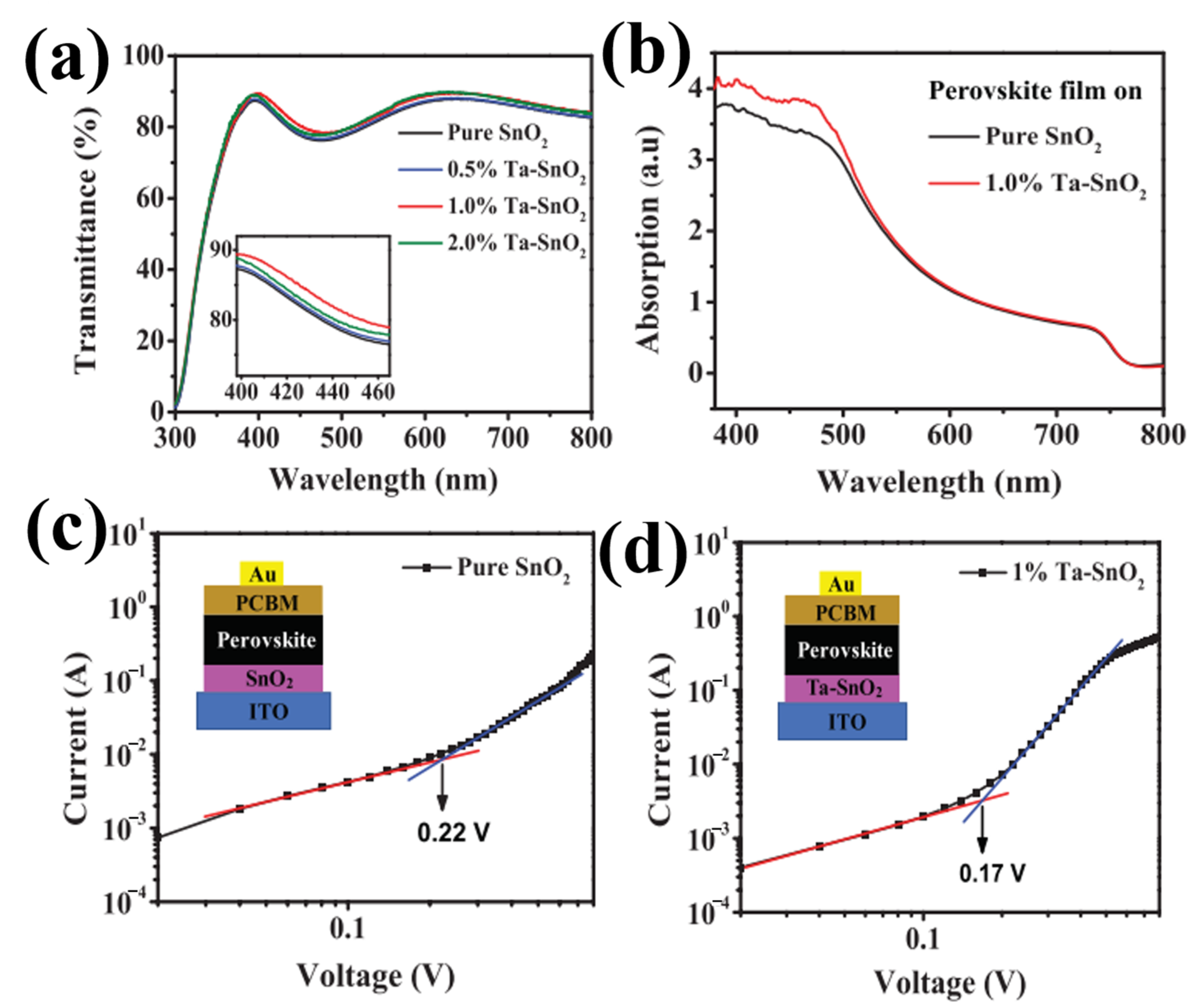
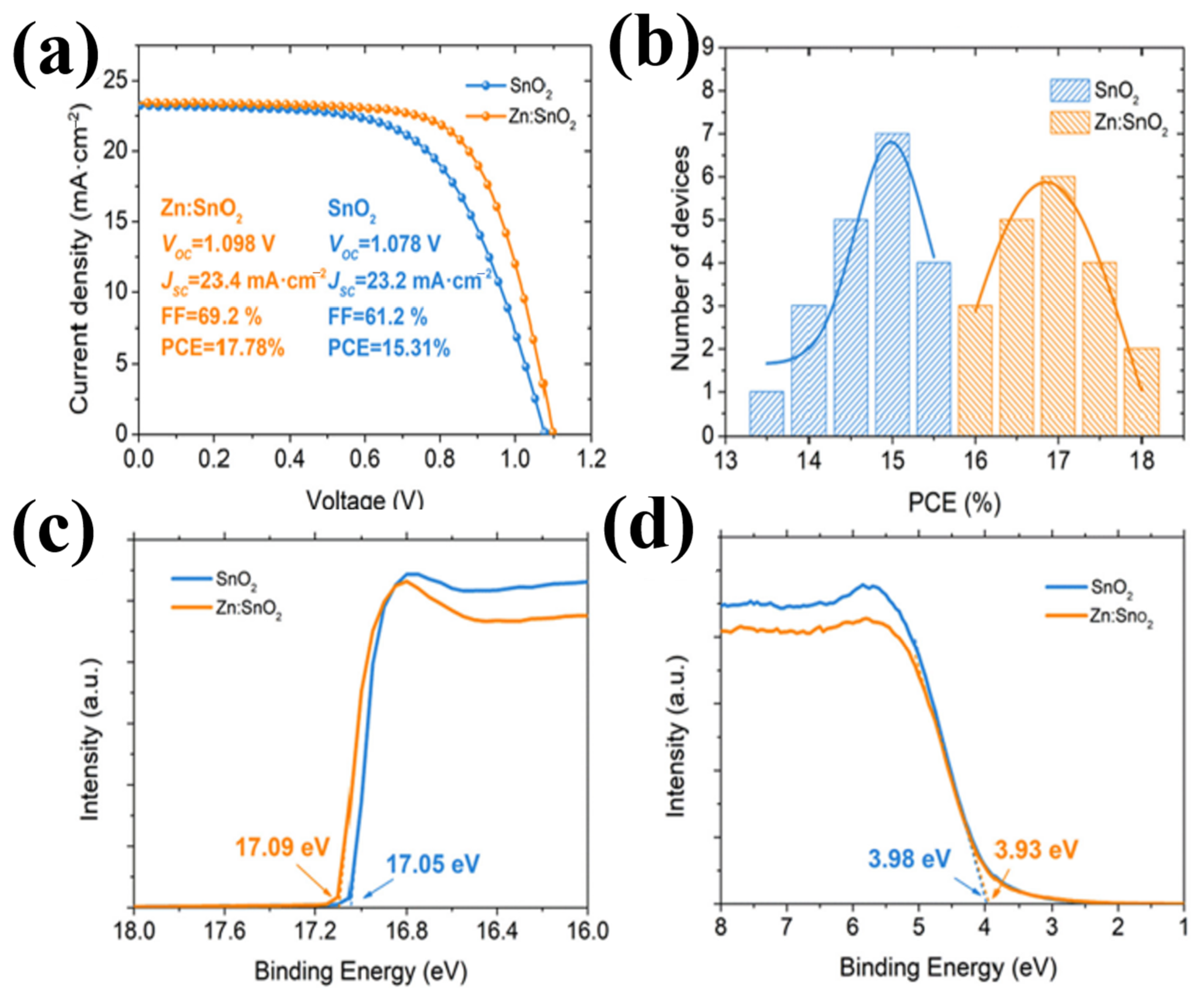


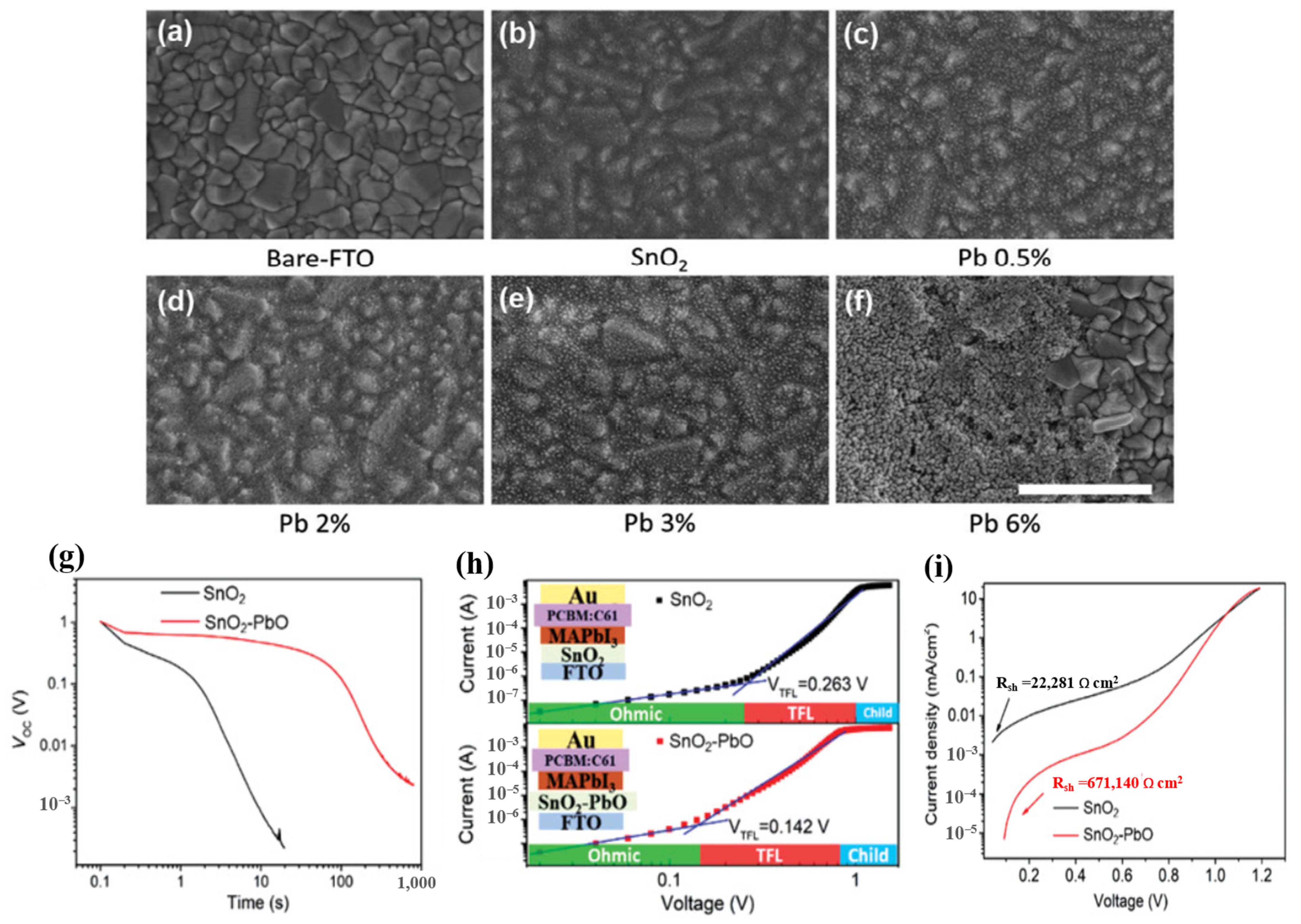
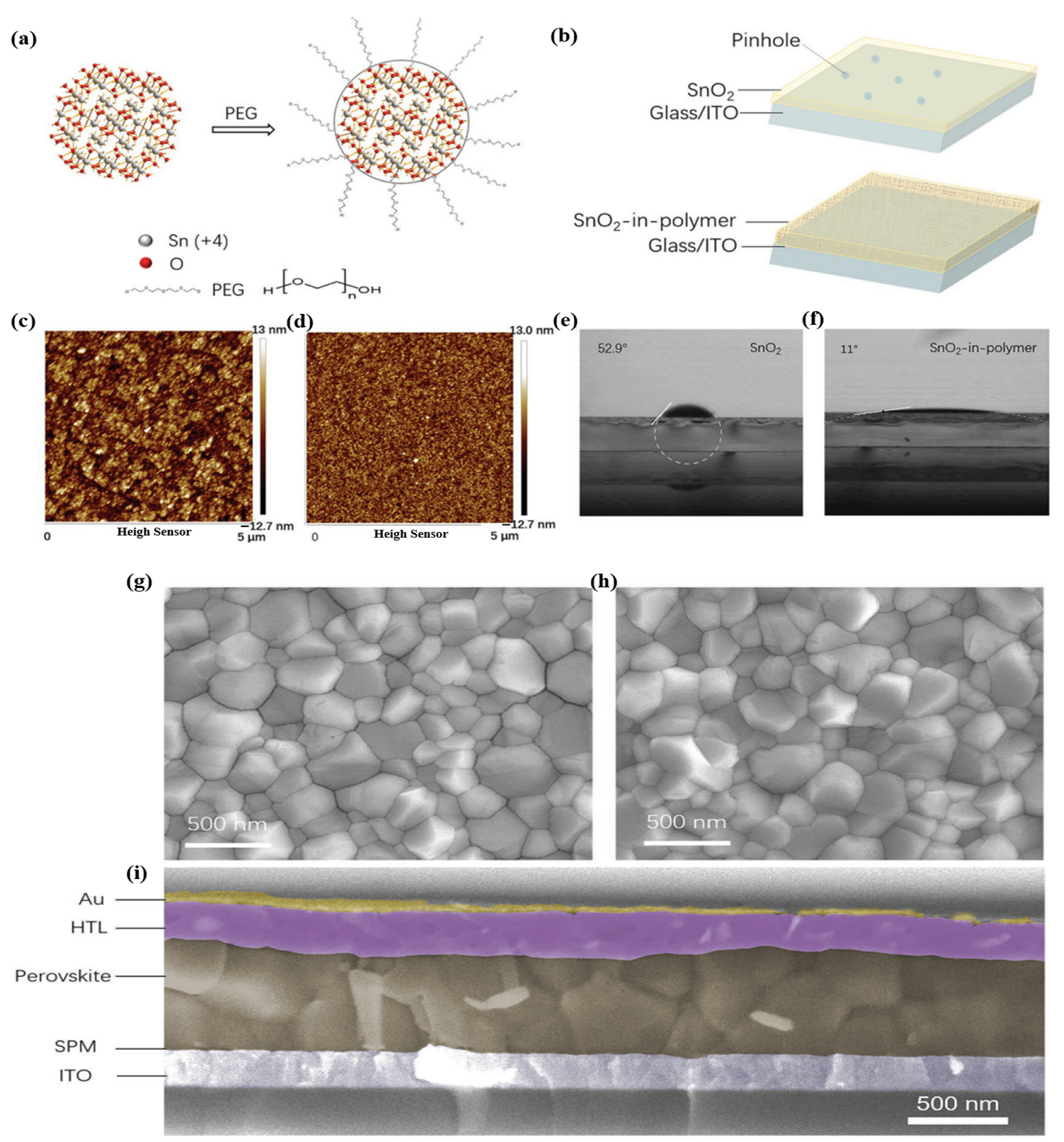
| Device Structure | Jsc (mA cm−2) | Voc (V) | FF | PCE (%) | Ref. |
|---|---|---|---|---|---|
| FTO/SnO2/Csx(MA0.17FA0.83)(100−x)Pb(I0.83Br0.17)3/CuPc/Carbon | 23.2 | 1.078 | 0.612 | 15.31 | |
| Zn-doped | 23.4 | 1.098 | 0.692 | 17.78 | [82] |
| AZO/SnO2/Csx(MA0.17FA0.83)(100−x)Pb(I0.83Br0.17)3/Spiro-OMeTAD/Au | 22.1 | 0.997 | 0.570 | 12.5 | |
| Ga-doped | 22.8 | 1.070 | 0.700 | 17.00 | [77] |
| ITO/SnO2/Csx(MA0.17FA0.83)(100−x)Pb(I0.83Br0.17)3/Spiro-OMeTAD/Au | 21.7 | 1.158 | 0.777 | 19.48 | |
| Ta-doped | 22.8 | 1.161 | 0.786 | 20.80 | [76] |
| FTO/SnO2/TiO2-MAPbI3-ZrO2/Carbon | 22.8 | 0.880 | 0.610 | 12.32 | |
| Nb-doped | 24.1 | 0.920 | 0.610 | 13.53 | [79] |
| ITO/SnO2/Csx(MA0.17FA0.83)(100−x)Pb(I0.83Br0.17)3/Spiro-OMeTAD/Au | 22.4 | 1.114 | 0.718 | 18.05 | |
| Nb-doped | 22.9 | 1.125 | 0.736 | 18.92 | [70] |
| FTO/SnO2/CsFAMA/Spiro-OMeTAD/Au | 22.7 | 1.130 | 0.727 | 18.64 | |
| Nb-doped | 23.2 | 1.100 | 0.786 | 20.07 | [80] |
| FTO/SnO2/CsPBBr3/Carbon | 7.5 | 1.270 | 0.648 | 6.73 | |
| Nb-doped | 8.9 | 1.290 | 0.695 | 8.54 | [78] |
| FTO/SnO2/CsFAMA/Spiro-OMeTAD/Ag | 23.2 | 1.078 | 0.771 | 19.43 | |
| Cu-doped | 24.2 | 1.108 | 0.790 | 21.35 | [81] |
| ITO/SnO2/(FAPbI3)0.95(MAPbBr3)0.05/Spiro-OMeTAD/Au | 24.3 | 1.060 | 0.660 | 17.30 | |
| Zr-doped | 24.7 | 1.080 | 0.720 | 19.54 | [83] |
| ITO/SnO2/(FAPbI3)0.95(MAPbBr3)0.05/Spiro-OMeTAD/Au | 22.8 | 0.993 | 0.780 | 17.43 | |
| Gd-doped | 23.8 | 1.143 | 0.820 | 22.40 | [89] |
| FTO/SnO2/MAPbI3/Spiro-OMeTAD/Au | 20.7 | 1.060 | 0.650 | 14.24 | |
| La-doped | 21.8 | 1.090 | 0.720 | 17.08 | [85] |
| FTO/SnO2/CH3NH3PbI3/Spiro-OMeTAD/Au | 18.6 | 1.030 | 0.610 | 11.69 | |
| Y-doped | 21.8 | 1.070 | 0.670 | 15.60 | [88] |
| FTO/SnO2/(FAPbI3)0.85(MAPbBr3)0.15/Spiro-OMeTAD/Au | 21.0 | 1.020 | 0.59 | 15.07 | |
| Cl-doped | 23.0 | 1.110 | 0.69 | 18.10 | [91] |
| FTO/SnO2/MAPbI3/Spiro-OMeTAD/Au | 16.8 | 1.000 | 0.530 | 9.02 | |
| Al-doped | 19.4 | 1.030 | 0.580 | 12.10 | [86] |
| ITO/SnO2/MAPbI3/Spiro-OMeTAD/Au | 22.3 | 1.010 | 0.696 | 15.70 | |
| Sb-doped | 22.6 | 1.060 | 0.742 | 17.70 | [71] |
| FTO/SnO2/CH3NH3PbI3/Spiro-OMeTAD/Au | 22.0 | 1.084 | 0.642 | 15.29 | |
| Li-doped | 23.3 | 1.106 | 0.707 | 18.20 | [87] |
| FTO/SnO2/(FAPbI3)0.85(MAPbBr3)0.15/Spiro-OMeTAD/Au | 22.7 | 1.030 | 0.700 | 16.35 | |
| Cl-doped | 24.3 | 1.070 | 0.730 | 18.94 | [90] |
| FTO/SnO2/Cs0.1FA0.9PbI3/Spiro-OMeTAD/Au | 25.3 | 1.044 | 0.715 | 18.89 | |
| NaCl-doped | 25.5 | 1.069 | 0.758 | 20.68 | [100] |
| FTO/SnO2/Cs0.04FA0.74MA0.22PbIxBryCl3−x−y/Spiro-OMeTAD/Au | 23.4 | 1.132 | 0.750 | 19.89 | |
| SbF3-doped | 24.2 | 1.146 | 0.771 | 21.42 | [103] |
| FTO/SnO2/(FAPbI3)0.92(MAPbBr3)0.08/Spiro-OMeTAD/Ag | 22.13 | 1.034 | 0.515 | 11.83 | |
| KCl-doped | 23.02 | 1.100 | 0.761 | 18.54 | [101] |
| ITO/SnO2/CsPbI2Br/Spiro-OMeTAD/MoO3/Ag | 14.6 | 1.180 | 0.778 | 13.40 | |
| KF-doped | 14.8 | 1.310 | 0.792 | 15.39 | [102] |
| ITO/SnO2/CH3NH3PbI3/Spiro-MeOTAD/Au | 20.1 | 1.080 | 0.668 | 14.58 | |
| Al2O3-doped | 22.9 | 1.140 | 0.731 | 19.10 | [106] |
| FTO/SnO2/CH3NH3PbI3/Spiro-MeOTAD/Au | 23.1 | 1.089 | 0.691 | 17.35 | |
| ZrF-doped | 24.4 | 1.105 | 0.718 | 19.19 | [104] |
| ITO/SnO2/PM6:Y6/MoO3/Ag | 24.0 | 0.820 | 0.648 | 12.73 | |
| PDINO-doped | 26.4 | 0.825 | 0.687 | 14.97 | [109] |
| ITO/SnO2/CsxFAyMA1-x-yPbI3-xClx/Spiro-OMeTAD/Ag | 21.8 | 1.070 | 0.740 | 18.74 | |
| PEIE-doped | 23.8 | 1.140 | 0.760 | 20.61 | [110] |
| ITO/SnO2/Cs0.04FA0.74MA0.22PbIxBryCl3−x−y/Spiro-OMeTAD/Au | 21.0 | 1.100 | 0.790 | 18.05 | |
| PVP-doped | 21.1 | 1.130 | 0.810 | 19.42 | [111] |
| ITO/SnO2/Cs0.05FA0.81MA0.14PbI2.55Br0.45/Spiro-OMeTAD/Au | 22.6 | 1.070 | 0.771 | 18.6 | |
| PEG-doped | 22.7 | 1.110 | 0.818 | 20.80 | [108] |
| ITO/SnO2/Cs0.05FA0.81MA0.14PbI2.55Br0.45/Spiro-OMeTAD/MoO3/Au | 23.1 | 1.070 | 0.778 | 19.15 | |
| CQDs-doped | 24.1 | 1.140 | 0.829 | 22.77 | [62] |
| FTO/SnO2/(FAPbI3)0.95(MAPbBr3)0.05/Spiro-OMeTAD/Au | 24.4 | 1.081 | 0.778 | 20.55 | |
| N-doped | 24.8 | 1.155 | 0.817 | 23.41 | [92] |
| FTO/SnO2/(FAPbI3)0.95(MAPbBr3)0.05/Spiro-OMeTAD/Au | 23.9 | 1.040 | 0.753 | 18.72 | |
| F-doped | 24.3 | 1.140 | 0.802 | 22.12 | [93] |
| ITO/SnO2/(FAPbI3)0.95(MAPbBr3)0.05/Spiro-OMeTAD/Ag | 21.8 | 1.150 | 0.732 | 18.41 | |
| P-doped | 22.6 | 1.140 | 0.767 | 19.72 | [94] |
| ETL | Device Structure | Jsc (mA cm−2) | Voc (V) | FF | PCE (%) | Ref. |
|---|---|---|---|---|---|---|
| TiO2 | FTO/TiO2/MAPbI3/Spiro-OMeTAD/Au | 23.31 | 1.172 | 0.765 | 20.90 | [112] |
| ZnO | ITO/ZnO/PBDB-T:ITIC/MoO3/Ag | 14.6 | 0.875 | 0.625 | 16.91 | [113] |
| WOx | FTO/WOx/(FAPbI3)1−x(MAPbBr3)x/Spiro-OMeTAD/Ag | 24.8 | 1.060 | 0.791 | 20.77 | [114] |
| Nb2O5 | ITO/NiOx/FA0.85MA0.15PbI2.55Br0.45/Nb2O5/Ag | 22.7 | 1.083 | 0.745 | 18.28 | [115] |
| SrTiO3 | ITO/SrTiO3/Cs0.07FA0.73MA0.20PbI2.53Br0.47/Spiro-OMeTAD/Au | 23.0 | 1.143 | 0.721 | 19.0 | [116] |
| BaSnO3 | FTO/BaSnO3/MAPbI3/Spiro-OMeTAD/Ag | 15.7 | 0.984 | 0.628 | 9.65 | [24] |
| CeOx | ITO/NiOx/MAPbI3/CeOx/Au | 22.5 | 1.010 | 0.754 | 17.47 | [117] |
| Cr2O3 | FTO/Cr2O3/Cs0.05(MA0.17FA0.83)0.95Pb(I0.83Br0.17)3/Spiro-OMeTAD/Au | 21.3 | 1.098 | 0.695 | 16.23 | [18] |
| In2O3 | FTO/In2O3/CH3NH3PbI3/Spiro-OMeTAD/Au | 19.3 | 1.070 | 0.678 | 13.97 | [118] |
| Fe2O3 | FTO/Fe2O3/CH3NH3PbI3/Spiro OMeTAD/Au | 16.6 | 0.650 | 0625 | 10.78 | [119] |
| Al2O3 | FTO/Al2O3/(FAPbI3)1−x(MAPbBr3)x/Spiro-OMeTAD/Ag | 22.8 | 1.060 | 0.670 | 16.23 | [120] |
| Eu2O3 | ITO/NiOx/CsPbI2 Br/Eu2O3/PCBM/Bphen/Ag | 15.28 | 1.140 | 0.776 | 13.47 | [121] |
| Zn(In)O | ITO/NiOx/Cs0.05(FA0.83MA0.17Pb(I0.83Br0.17))0.95/Zn(In)O/Al | 22.9 | 1.010 | 0.563 | 16.20 | [122] |
| Ti(Nb)Ox | ITO/NiOx/MAPbI3/PCBM/Ti(Nb)Ox/Ag | 21.9 | 1.070 | 0.790 | 18.49 | [123] |
| Zn2SnO4 | ITO/Zn2SnO4/PCBM/CH3NH3PbI3/Spiro-OMeTAD/Ag | 21.2 | 1.070 | 0.617 | 14.50 | [124] |
| N-doped SnO2 | FTO/N-dopedSnO2/(FAPbI3)0.95(MAPbBr3)0.05/Spiro-OMeTAD/Au | 24.8 | 1.155 | 0.817 | 23.41 | [92] |
Disclaimer/Publisher’s Note: The statements, opinions and data contained in all publications are solely those of the individual author(s) and contributor(s) and not of MDPI and/or the editor(s). MDPI and/or the editor(s) disclaim responsibility for any injury to people or property resulting from any ideas, methods, instructions or products referred to in the content. |
© 2023 by the authors. Licensee MDPI, Basel, Switzerland. This article is an open access article distributed under the terms and conditions of the Creative Commons Attribution (CC BY) license (https://creativecommons.org/licenses/by/4.0/).
Share and Cite
Hoang Huy, V.P.; Nguyen, T.M.H.; Bark, C.W. Recent Advances of Doped SnO2 as Electron Transport Layer for High-Performance Perovskite Solar Cells. Materials 2023, 16, 6170. https://doi.org/10.3390/ma16186170
Hoang Huy VP, Nguyen TMH, Bark CW. Recent Advances of Doped SnO2 as Electron Transport Layer for High-Performance Perovskite Solar Cells. Materials. 2023; 16(18):6170. https://doi.org/10.3390/ma16186170
Chicago/Turabian StyleHoang Huy, Vo Pham, Thi My Huyen Nguyen, and Chung Wung Bark. 2023. "Recent Advances of Doped SnO2 as Electron Transport Layer for High-Performance Perovskite Solar Cells" Materials 16, no. 18: 6170. https://doi.org/10.3390/ma16186170
APA StyleHoang Huy, V. P., Nguyen, T. M. H., & Bark, C. W. (2023). Recent Advances of Doped SnO2 as Electron Transport Layer for High-Performance Perovskite Solar Cells. Materials, 16(18), 6170. https://doi.org/10.3390/ma16186170






